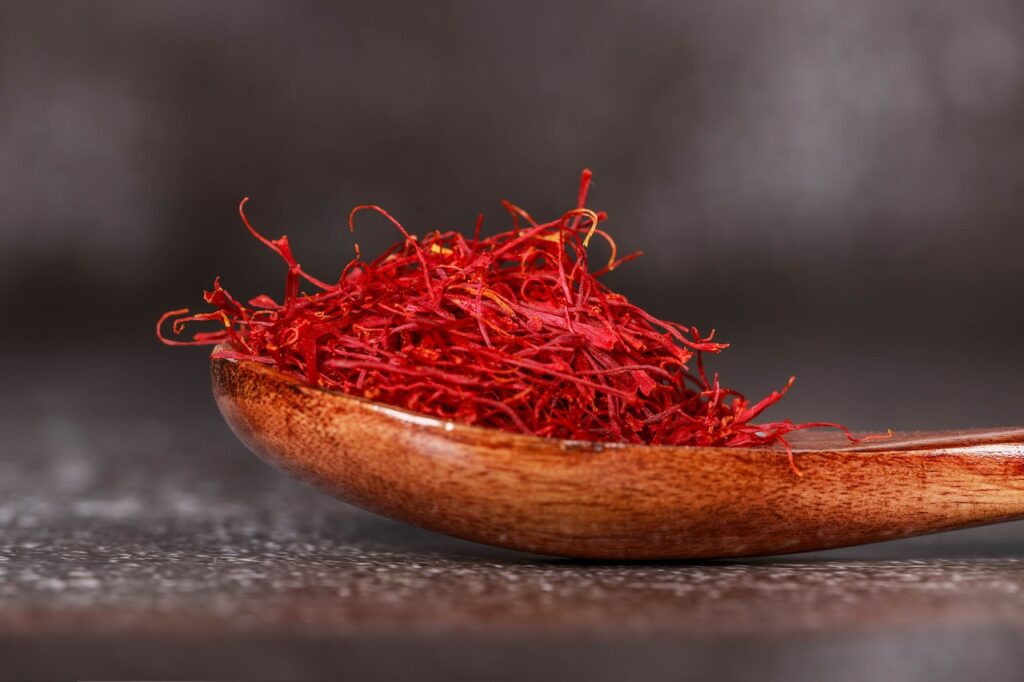
Kashmiri saffron, also known as “red gold,” is a prized spice that has captivated cultures and cuisines for centuries. Renowned for its vibrant color, distinct aroma, and exceptional flavor, Kashmiri saffron holds a special place in culinary traditions worldwide.
From ancient times to modern kitchens, this exquisite spice remains an irreplaceable ingredient, adding a touch of luxury and splendor to dishes that have stood the test of time.
The History and Origin of Kashmiri Saffron
Saffron is primarily found in Iran, although it is also grown in Spain, France, Italy (on the Apennines Range’s lower spurs), and parts of India. Kashmiri saffron, also known as “Kesar,” holds an enchanting history that traces back over 2,500 years. It is believed that saffron was introduced to the region by Persian traders who recognized the favorable climate and soil of the Kashmir Valley for cultivating this prized spice. The local environment, with its cool temperatures, abundant sunlight, and well-drained soil, proved to be the perfect nurturing ground for saffron crocus (Crocus sativus).
Over the centuries, Kashmiri saffron has established its reputation as the finest and most aromatic variety of saffron globally, drawing connoisseurs from around the world to experience its unparalleled flavor and aroma.
Types of Saffron in Kashmir
In Kashmir, there are mainly three types of saffron, each differing in quality and characteristics:
1. Lachha Saffron:
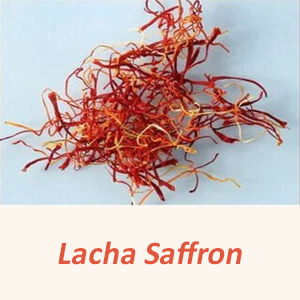
This is the most common and widely available type of saffron in Kashmir. It consists of saffron stigmas that are separated from the style in a relatively simple process. Lachha saffron is affordable and suitable for regular culinary use.
2. Mongra Saffron:
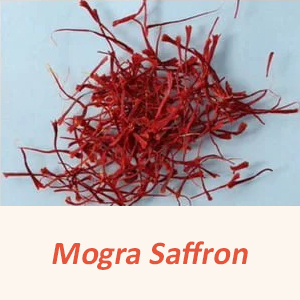
Mongra saffron is of a higher quality compared to Lachha saffron. It includes saffron stigmas that are longer and thicker, often with a deep red color. This type of saffron is more potent and is preferred for its aromatic and flavor-enhancing qualities. It is used in various culinary dishes and beverages.
3. Zarda Saffron:
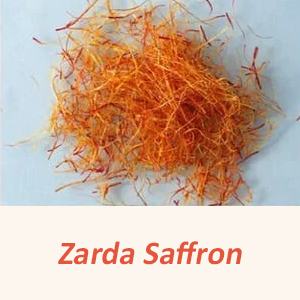
Zarda saffron, a lower-grade Kashmiri variant, holds a paler red hue with a more yellow style. Its aroma and flavor are milder than higher grades like Mongra. Despite reduced potency, it’s used for subtle coloring and flavoring in cooking, offering an economical option with a hint of saffron’s characteristic traits.
4. Guchhi Saffron:
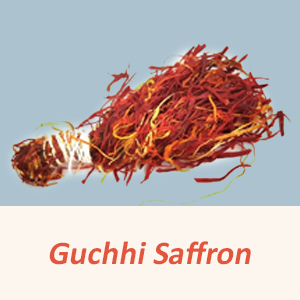
Guchhi saffron is the most premium and rare type of saffron found in Kashmir. It is made up of the entire stigma along with a part of the style, giving it a unique appearance with a thread-like extension. Guchhi saffron is highly prized for its intense flavor, aroma, and deep crimson color. It is considered the finest saffron and is used in luxurious culinary preparations and traditional medicine.
Cultivation and Harvesting of Kashmiri Saffron

Cultivating Kashmiri saffron is an intricate process that demands patience, precision, and skilled labor. The cultivation begins in late summer, as the saffron crocus bulbs are planted in well-prepared fields. The bulbs then lie dormant throughout the winter, awaiting the arrival of spring.
With the onset of spring, the beautiful violet-hued flowers bloom, revealing three delicate, crimson-red stigmas – the saffron threads. These threads are the true essence of Kashmiri saffron, and their harvesting must be done with utmost care. Skilled farmers handpick each delicate stigma early in the morning to ensure the maximum flavor and aroma are preserved.
It is an arduous process, as it takes an astonishing 150,000 to 200,000 flowers to produce just one kilogram of saffron, making it one of the most labor-intensive spices in the world.
The Distinctive Qualities of Kashmiri Saffron
Kashmiri saffron boasts unique qualities that distinguish it from other varieties. Its long, crimson threads are known for their deep coloring and potent flavor. The saffron threads are rich in crocin, the natural pigment responsible for the vibrant red color, and safranal, the aromatic compound that imparts its distinct aroma.
Beyond its culinary applications, Kashmiri saffron is also valued for its medicinal properties. It is believed to possess antioxidant, anti-inflammatory, and mood-enhancing attributes, making it a valuable addition to traditional medicine practices.
Culinary Applications of Kashmiri Saffron

The enchanting aroma and vibrant hue of Kashmiri saffron make it an irreplaceable spice in various culinary delights. Its versatile nature allows it to be used in both sweet and savory dishes, adding an exotic touch to each creation.
- Saffron-Infused Beverages: Saffron tea, also known as “Kahwa,” is an iconic Kashmiri beverage cherished for its exquisite taste and aroma. This traditional concoction blends green tea leaves, saffron threads, cardamom, cinnamon, and crushed almonds, creating a truly rejuvenating experience.
- Rich and Creamy Desserts: Kashmiri saffron elevates desserts to a whole new level. From the classic “Phirni” and “Kheer” to the aromatic “Shufta” and “Zafrani Halwa,” saffron imparts its magical touch, making these delicacies an indulgent treat.
- Savory Elegance: In savory dishes, Kashmiri saffron creates an air of sophistication. It enhances the flavors of traditional rice dishes like “Saffron Pulao” and savory “Yakhni” gravies, delighting the taste buds with its exotic allure.
The Most Expensive Spice in Kashmir
Saffron is one of the most expensive spices produced in Kashmir. Kashmiri saffron, known for its superior quality and unique flavor, is highly prized worldwide. The region’s climate and soil conditions contribute to the cultivation of this valuable spice, making it one of the premium varieties of saffron available globally.
Top 10 Benefits of Kashmiri Saffron
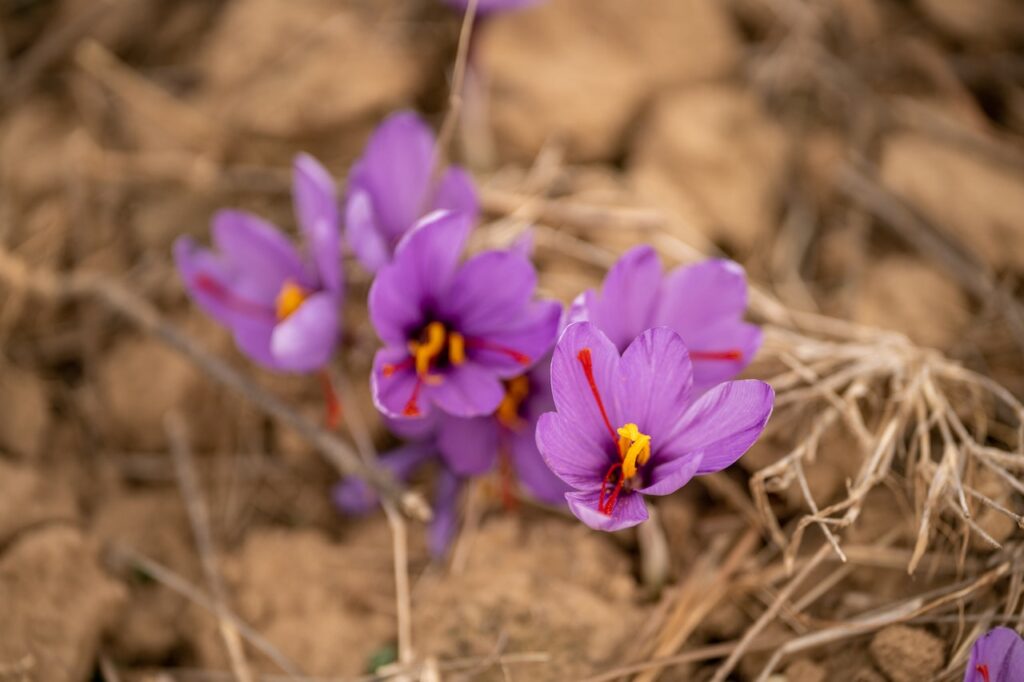
Kashmiri saffron, also known as “Kesar,” is not only a culinary delight but also a treasure trove of health benefits. For centuries, it has been cherished in traditional medicine for its therapeutic properties. Below are some of the significant benefits of Kashmiri saffron:
- Powerful Antioxidant: Kashmiri saffron is rich in antioxidants like crocin and safranal, which help combat oxidative stress and neutralize free radicals. These antioxidants play a crucial role in protecting cells from damage and reducing the risk of chronic diseases.
- Anti-Inflammatory Properties: The active compounds in saffron have anti-inflammatory effects, making it beneficial in reducing inflammation throughout the body. This property can be particularly helpful for individuals with inflammatory conditions like arthritis and other inflammatory disorders.
- Mood Enhancement: Saffron is known to have mood-enhancing properties, acting as a natural antidepressant. It can help alleviate mild to moderate depression symptoms and promote a sense of well-being by modulating neurotransmitters in the brain.
- Supports Cognitive Function: Studies suggest that saffron may have cognitive benefits, including improved memory and enhanced learning ability. The spice is believed to protect brain cells from damage and may aid in age-related cognitive decline.
- Promotes Heart Health: Kashmiri saffron has been linked to promoting heart health by lowering cholesterol levels and maintaining healthy blood pressure. The presence of potassium in saffron can also help reduce the risk of cardiovascular diseases.
- Digestive Aid: In traditional medicine, saffron has been used to aid digestion and relieve gastrointestinal issues. It can help reduce stomach discomfort and improve digestion by promoting the secretion of digestive enzymes.
- Regulates Blood Sugar: Some studies suggest that saffron may help regulate blood sugar levels, making it beneficial for individuals with diabetes or those at risk of developing diabetes.
- Supports Respiratory Health: Saffron is believed to have beneficial effects on the respiratory system, helping to alleviate symptoms of respiratory disorders like asthma and cough.
- Enhances Skin Health: The antioxidant and anti-inflammatory properties of saffron contribute to its benefits for skin health. It may help improve skin texture, reduce acne, and promote a radiant complexion.
- Aphrodisiac Properties: In various cultures, saffron has been regarded as an aphrodisiac, believed to enhance libido and improve sexual function.
It’s important to note that while saffron offers numerous health benefits, it should be consumed in moderation. Excessive intake may have adverse effects or interact with certain medications. Pregnant women should also exercise caution, as large amounts of saffron consumption may stimulate uterine contractions.
Buying and Storing Kashmiri Saffron
When purchasing Kashmiri saffron, it is crucial to ensure its authenticity and purity. Look for saffron threads that have a deep red color and a strong, distinct aroma. Avoid buying powdered saffron, as it might be mixed with other substances or less potent varieties.
To store saffron, keep it away from direct sunlight and in an airtight container. Stored properly, Kashmiri saffron can maintain its freshness and flavor for up to two years.



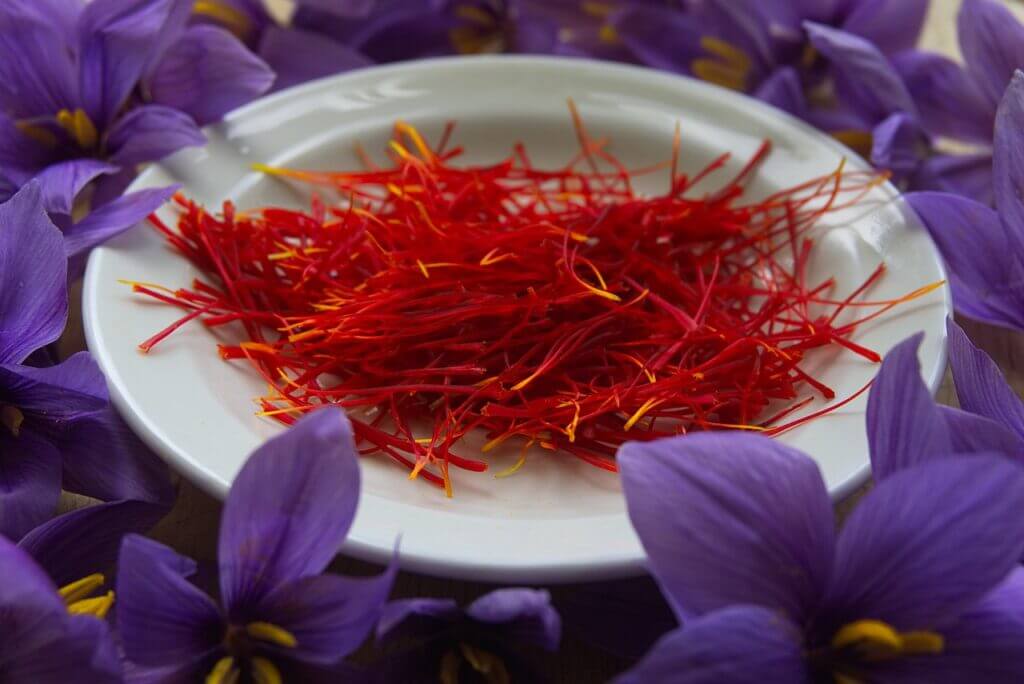

People also ask
-
How to use saffron with milk?
Warm milk, add a pinch of crushed saffron. Soak for 10-15 mins. Optionally sweeten. Serve hot or chilled. Enjoy the aromatic, flavorful saffron milk with potential health benefits.
-
How to use saffron to cook rice?
Soak saffron in warm water or milk for 10-15 mins. Add the infusion to boiling water or broth for rice. Cook rice as usual—fluff with a fork. Enjoy fragrant saffron rice.
-
How to use saffron with chicken?
Crush a pinch of saffron threads and soak in warm water for 10-15 mins. Marinate chicken with saffron infusion, along with other desired spices and ingredients. Cook chicken as per your preferred recipe, allowing the saffron to infuse its flavor. Enjoy the rich and aromatic saffron-infused chicken dish.
-
How to use saffron in biryani?
Soak a pinch of saffron threads in warm milk for 10-15 mins. Prepare the biryani as usual, layering rice and marinated meat. Drizzle the saffron milk over the top rice layer. Cover and cook on low heat until fully cooked. Serve fragrant saffron-infused biryani and enjoy!
-
What are the Saffron benefits for females?
Saffron benefits for females include menstrual relief, mood enhancement, aphrodisiac properties, antioxidant support, skincare benefits, and potential heart health improvement. Consult a healthcare professional for personalized advice.
-
How do I use Kashmiri saffron in cooking?
Soak a pinch of saffron threads in warm liquid (water or milk) for 10-15 mins. Add the infusion to dishes like rice, biryani, desserts, and stews for flavor and color.
-
Can I use Kashmiri saffron in sweet and savory dishes?
Yes, Kashmiri saffron complements both sweet and savory recipes. It enhances the taste and adds a beautiful golden hue to various dishes.
-
What are some popular saffron-infused dishes in Kashmiri cuisine?
Kashmiri Pulao, Saffron Milk, Kesar Phirni, Rogan Josh, and Zaffrani Kofta are some famous dishes that use Kashmiri saffron to impart unique flavors.
-
How much Kashmiri saffron should I use in recipes?
A little goes a long way. Generally, a pinch (10-15 threads) of saffron is sufficient for a dish serving 4-6 people. Adjust based on personal preference.
-
Can I store Kashmiri saffron for a long time?
To maintain freshness, store saffron in an airtight container in a cool, dark place. It can retain its potency for up to 2-3 years.
-
Can I use Kashmiri saffron in non-traditional dishes?
Absolutely! Experiment with saffron in cakes, ice creams, drinks, and more. Its versatility allows for creative culinary exploration.
-
Is Kashmiri saffron safe for pregnant women?
In moderation, Kashmiri saffron is considered safe during pregnancy. However, pregnant women should consult their healthcare provider before using it.
Wrap up on Kashmiri Saffron in Cooking
Kashmiri saffron, the golden treasure of the valley, has enchanted the culinary world for millennia. Its rich history, laborious cultivation process, and unparalleled flavor and aroma make it one of the most coveted spices globally. Whether infused in a cup of saffron tea or adding vibrancy to an exquisite dessert, Kashmiri saffron is a true delicacy that enhances the essence of every dish it graces. As you explore the world of gastronomy, let Kashmiri saffron be your culinary companion, taking your taste buds on a delightful journey through the mesmerizing flavors of the Kashmir Valley.
